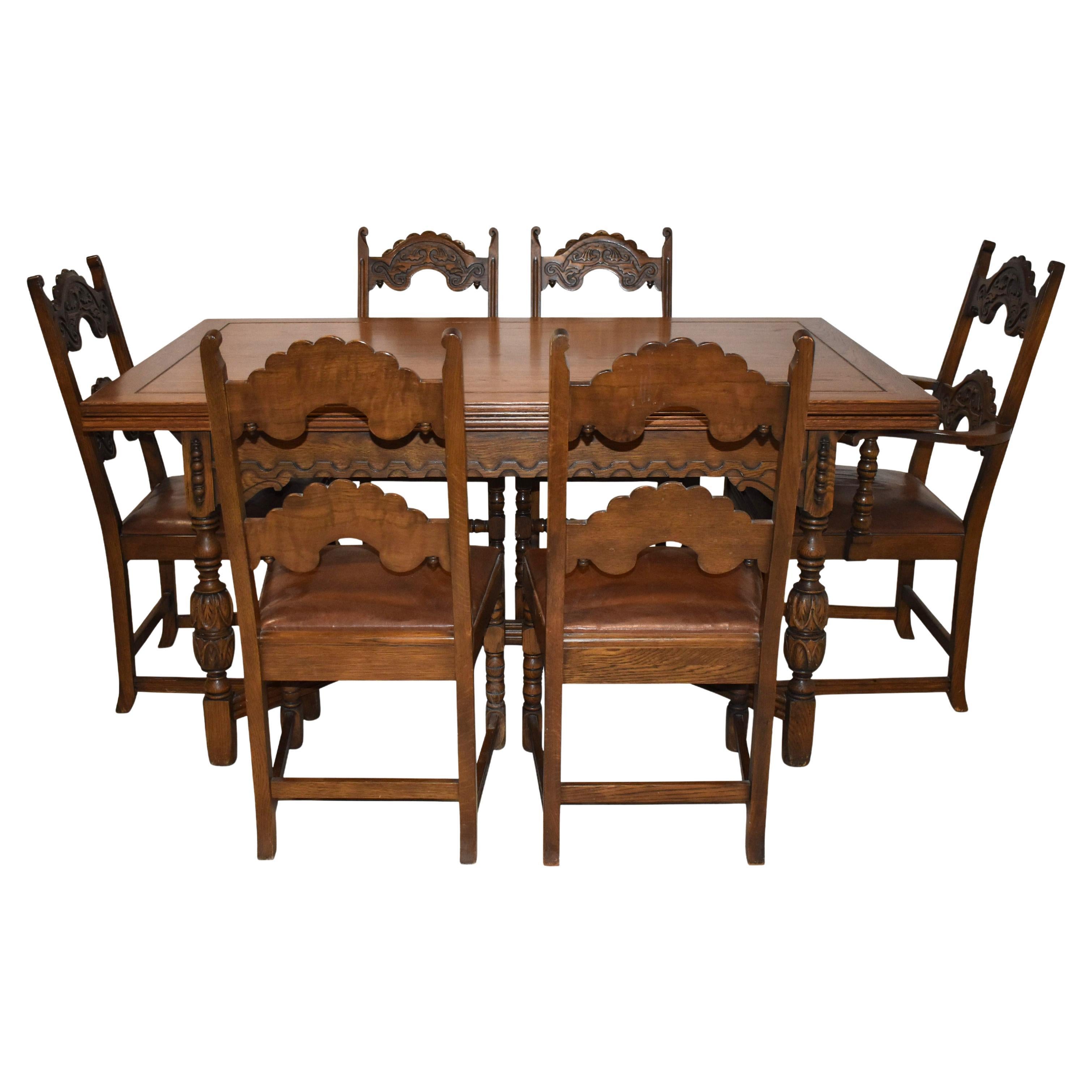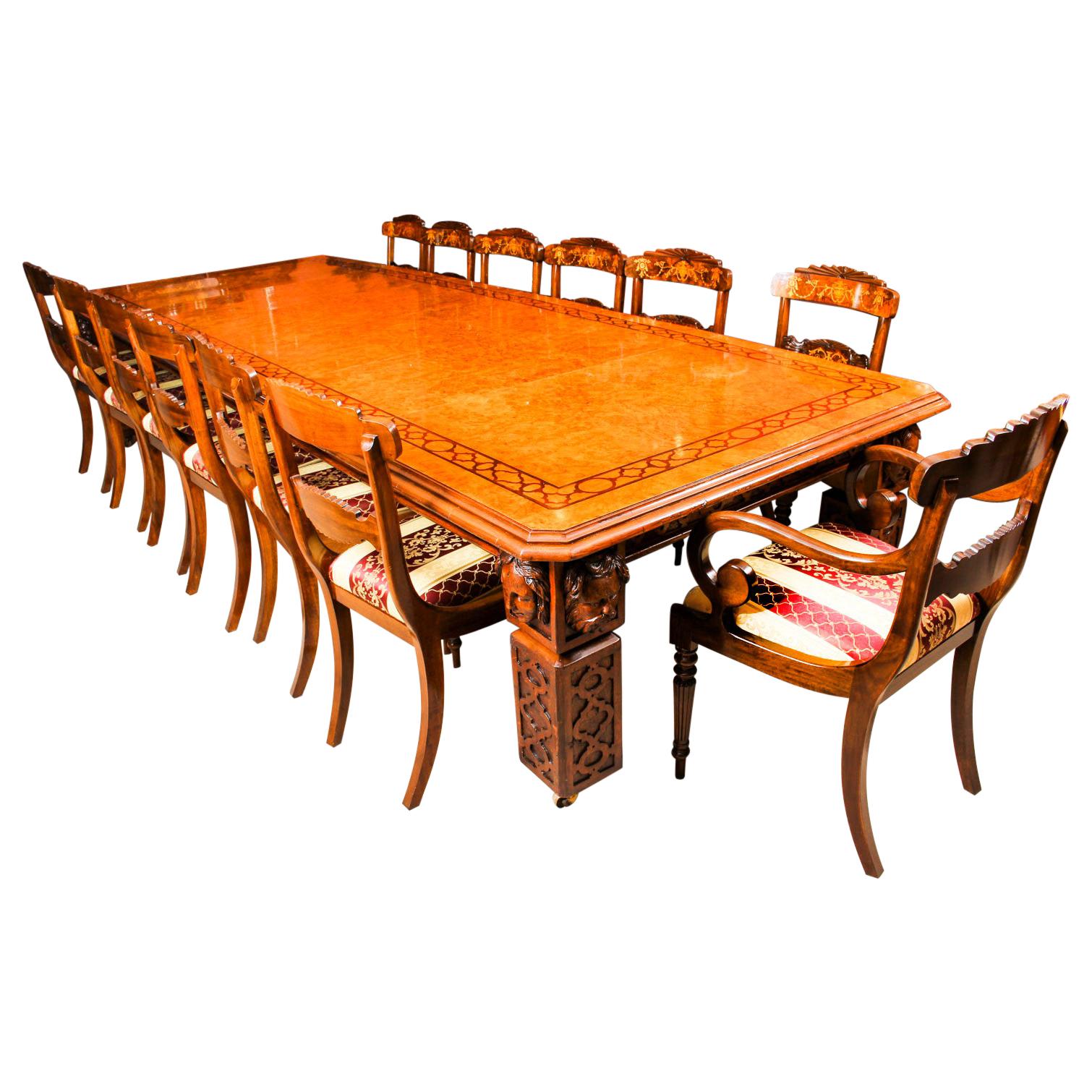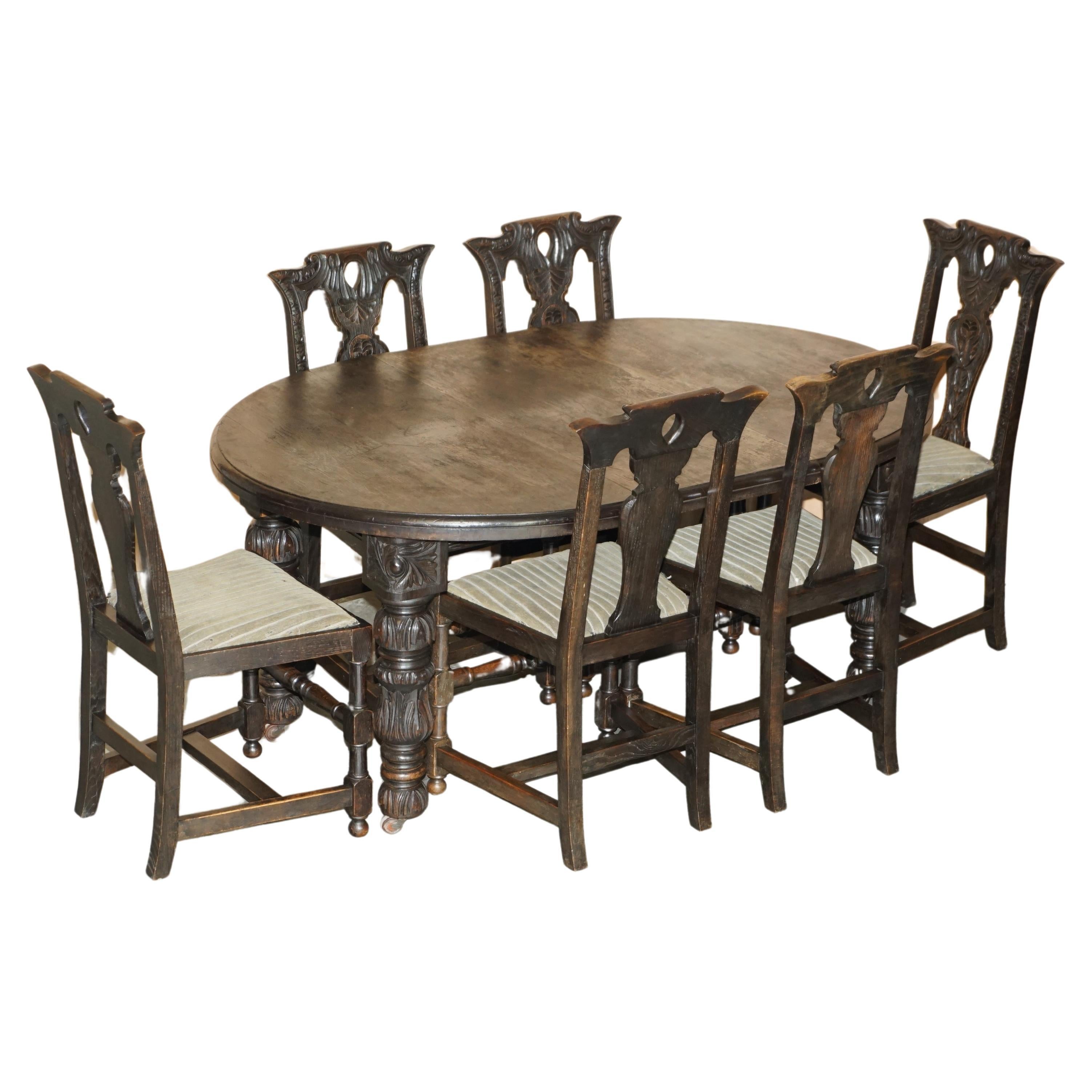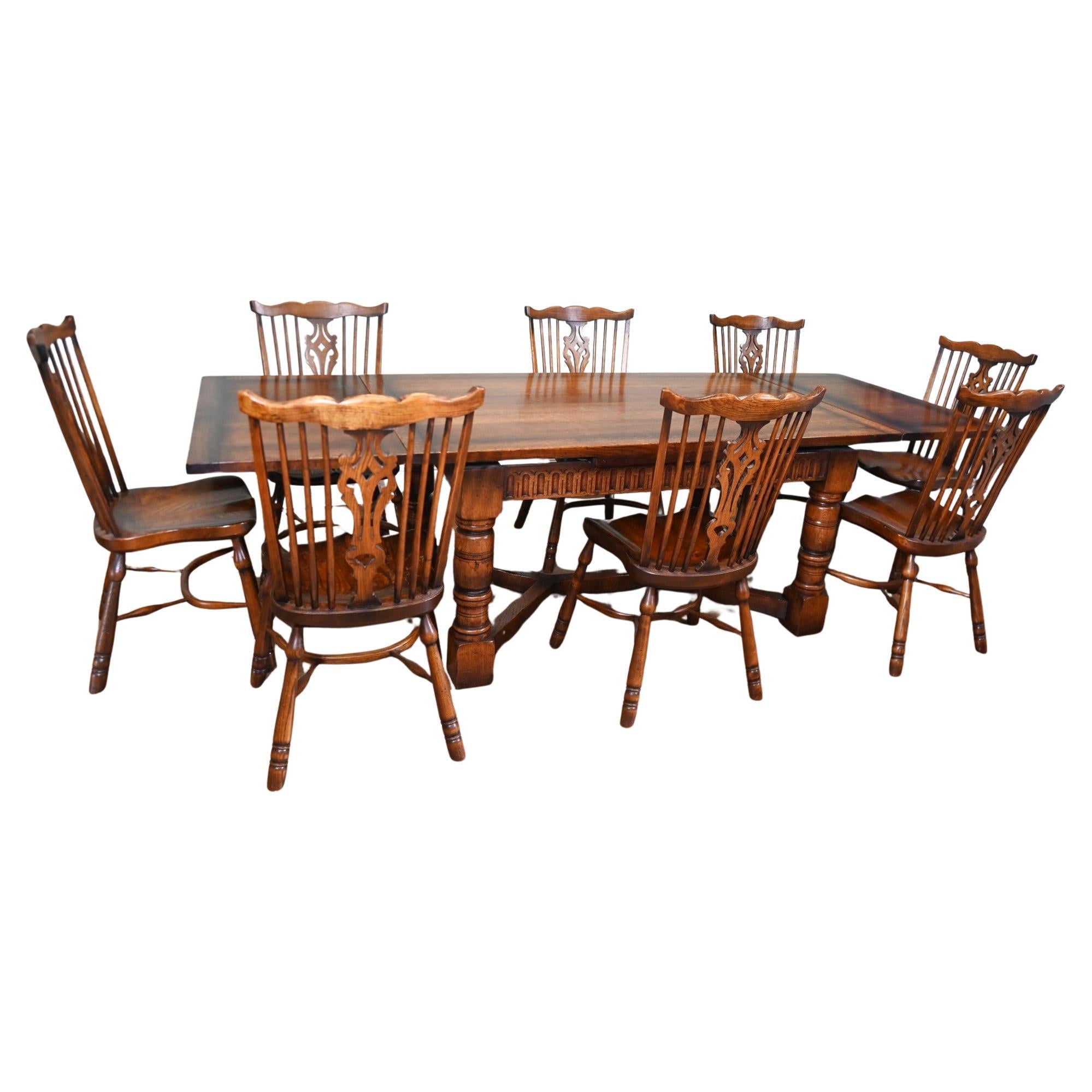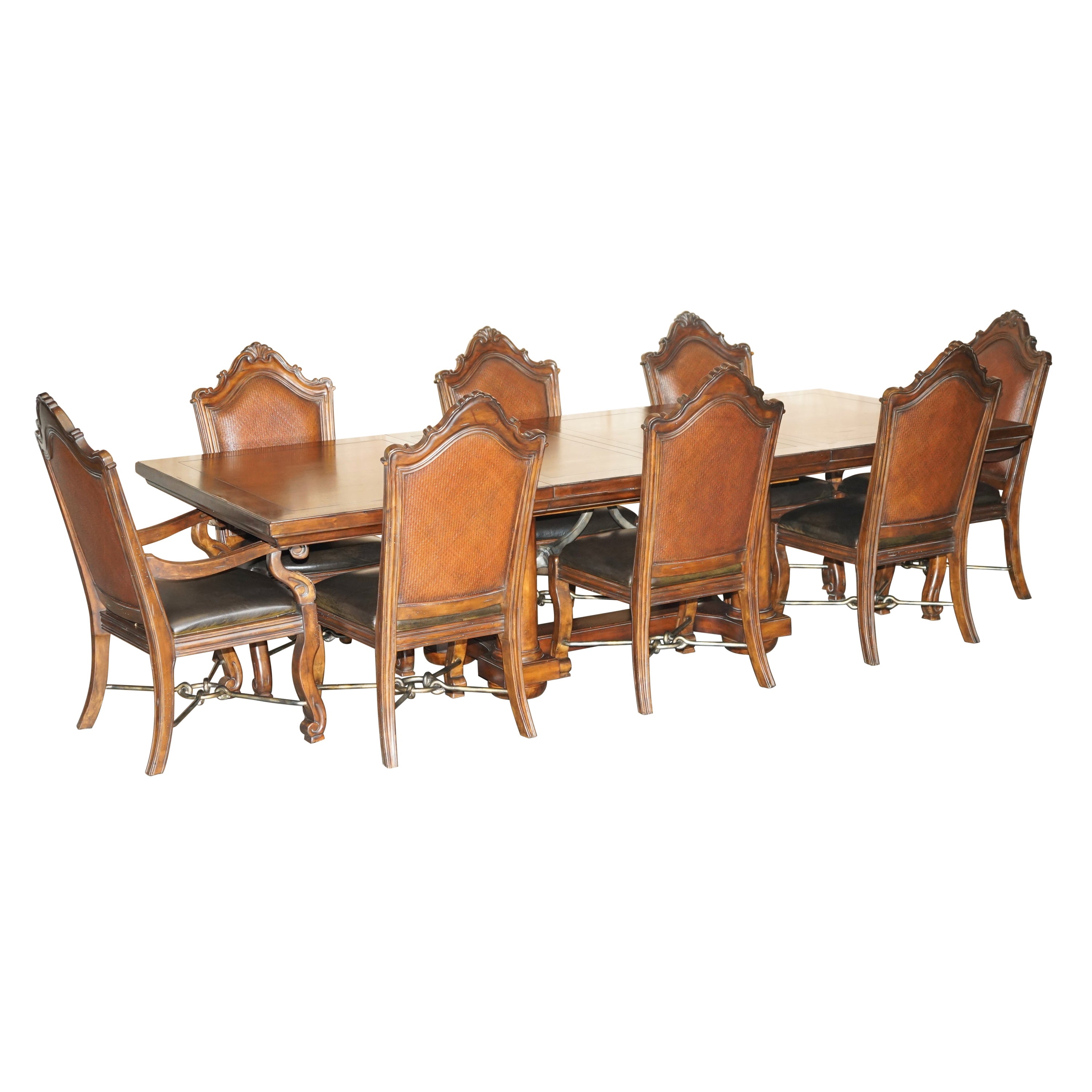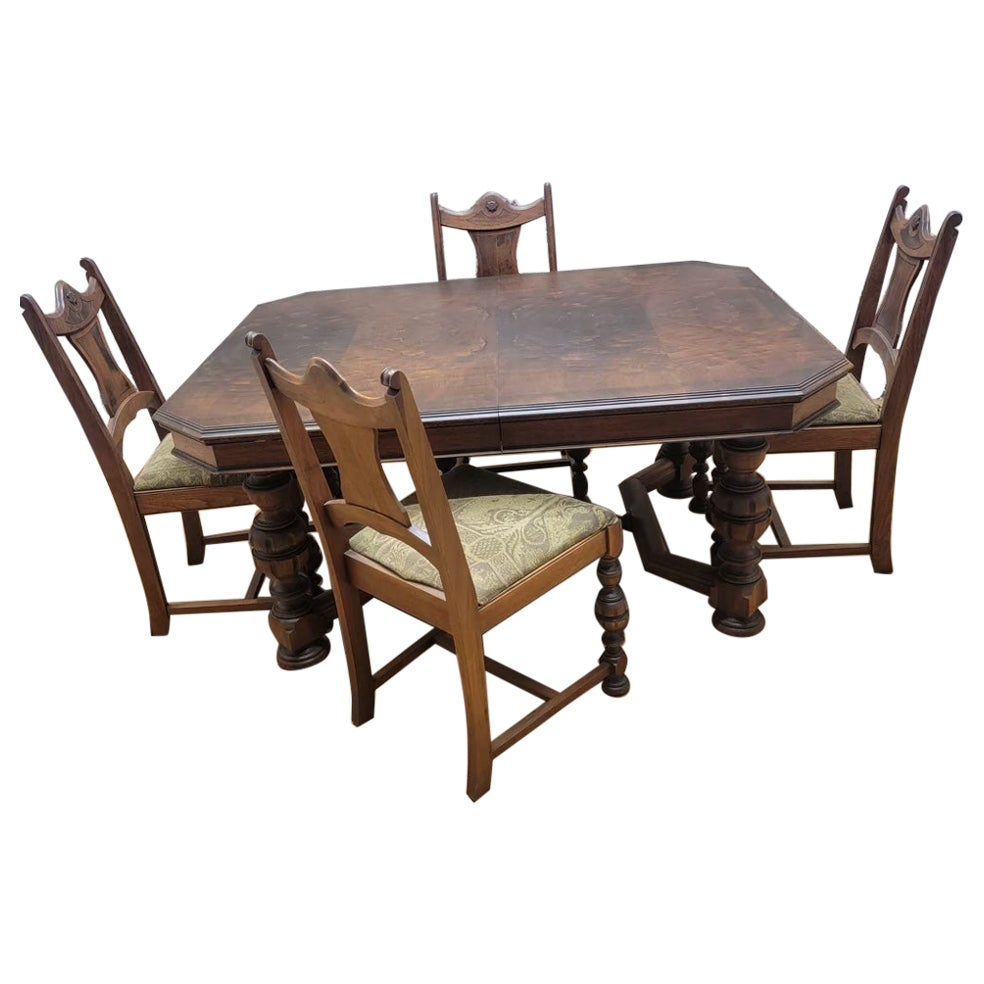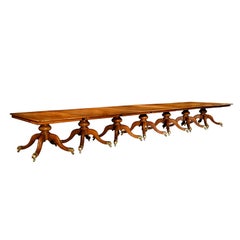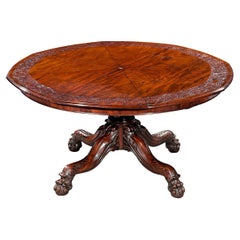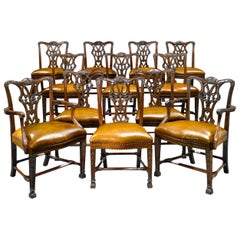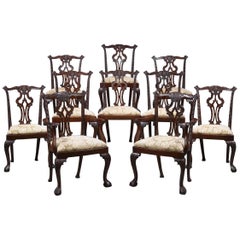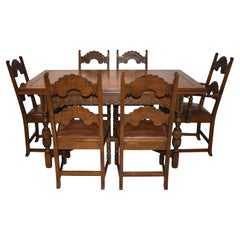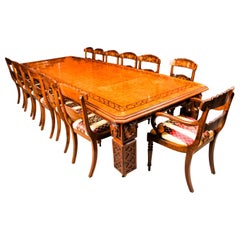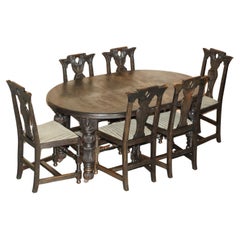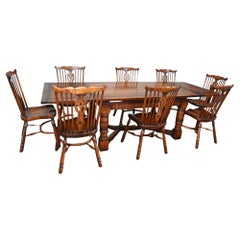Items Similar to American Oak Dining Suite by R.J. Horner
Want more images or videos?
Request additional images or videos from the seller
1 of 21
American Oak Dining Suite by R.J. Horner
$148,500per set
£113,700.20per set
€130,264.65per set
CA$211,903.65per set
A$231,924.96per set
CHF 120,555.73per set
MX$2,791,296.73per set
NOK 1,515,575.95per set
SEK 1,421,657.43per set
DKK 972,992.69per set
About the Item
This outstanding 13-piece Victorian dining suite by R.J. Horner of New York boasts intricate hand carving rarely seen in furnishings of the era. Crafted of fine golden oak, the suite features eight dining chairs, a versatile dining table, a vitrine, a sideboard, a buffet and a chest that holds the leaves of the dining table. Each piece is detailed with a myriad of lavishly hand-carved figures, including winged lions, fanciful masks, dragons and maidens. The dining table was surely crafted with flexibility in mind, as inside the accompanying chest are nine leaves which allow the table to expand an additional seven feet in length from its original square dimensions. In terms of size and craftsmanship, this suite is a shining example of Victorian furniture.
The period between 1880 and 1920 is often regarded as the “golden age” of American furniture craftsmanship, not only for the quality of the pieces, but also for the characteristic golden lacquers applied to finished furnishings. Overall prosperity following the American Civil War gave rise to wealthier families, larger homes and, hence, a desire for larger, more ornate furnishings for those homes.
Oak became popular during this time, due to a shortage of available walnut. In particular, the New York firm of Robert J. Horner is known for creating some of the greatest, handcrafted oak furnishings of this period. Horner was a clerk at a curtain shop before opening his furnishing business in 1885. Although the firm lasted only 30 years, the pieces that were produced during that time displayed high-level carving and handmade craftsmanship that was seldom seen during the Victorian Age, which was largely marked by mechanized work and industrialism. Today, items crafted by Horner are highly desirable and sought by collectors of premium Victorian furniture.
Circa 1885
Chairs: 19 1/2” wide x 47 3/4” high
Table (without leaves): 53” wide x 53” length x 30 1/4” high
Table (with leaves): 140 1/2” length
Sideboard: 74 1/2” wide x 25 3/4” deep x 48” high
Buffet: 44” wide x 18” deep
Vitritne: 55 1/2" wide x 19 1/2" deep x 81 3/4" high
Leaf Chest: 54 1/2" wide x 21" deep x 21" deep.
- Creator:R.J. Horner & Co. (Maker)
- Dimensions:Height: 30.25 in (76.84 cm)Width: 53 in (134.62 cm)Depth: 140.5 in (356.87 cm)
- Sold As:Set of 13
- Style:Victorian (In the Style Of)
- Materials and Techniques:
- Place of Origin:
- Period:
- Date of Manufacture:circa 1885
- Condition:
- Seller Location:New Orleans, LA
- Reference Number:Seller: 29-32471stDibs: LU891129341072
About the Seller
5.0
Recognized Seller
These prestigious sellers are industry leaders and represent the highest echelon for item quality and design.
Established in 1912
1stDibs seller since 2010
113 sales on 1stDibs
Typical response time: 9 hours
- ShippingRetrieving quote...Shipping from: New Orleans, LA
- Return Policy
Authenticity Guarantee
In the unlikely event there’s an issue with an item’s authenticity, contact us within 1 year for a full refund. DetailsMoney-Back Guarantee
If your item is not as described, is damaged in transit, or does not arrive, contact us within 7 days for a full refund. Details24-Hour Cancellation
You have a 24-hour grace period in which to reconsider your purchase, with no questions asked.Vetted Professional Sellers
Our world-class sellers must adhere to strict standards for service and quality, maintaining the integrity of our listings.Price-Match Guarantee
If you find that a seller listed the same item for a lower price elsewhere, we’ll match it.Trusted Global Delivery
Our best-in-class carrier network provides specialized shipping options worldwide, including custom delivery.More From This Seller
View AllIncredible English Mahogany Seven-Pedestal Dining Table
Located in New Orleans, LA
Measuring over 30 feet in length, this tremendous and highly versatile English dining table is the greatest. It has the ability to transform to a multitude of sizes to fit any occasi...
Category
Antique 19th Century British Neoclassical Dining Room Tables
Materials
Brass
Expanding Jupe Dining Table by Johnstone and Jeanes
By Robert Jupe
Located in New Orleans, LA
This exceptionally rare circular expanding dining table was designed by Robert Jupe and crafted by the English cabinetmakers Johnstone & Jeanes, successors to Johnstone, Jupe & Co. One of only a handful known from the firm, this table illustrates the Victorian era's quest to combine technical innovation with superb and beautiful craftsmanship. Complete with its original leaves, the table’s circular top is formed from eight separate segments. When the top is rotated, an ingenious swivel mechanism causes the sections to diverge, allowing a set of small or large leaves to be inserted for an adjustable increase in size.
The design for the table was patented by Robert Jupe in 1835, who had envisioned “an improved expanding table so constructed that the sections composing its surface may be caused to diverge from a common center and that the spaces caused thereby may be filled up by inserting leaves or filling pieces.” The first of these fascinating tables were created between 1835 and 1840 during his partnership with John Johnstone and their firm of Johnstone, Jupe & Co. in London. Jupe left the company in 1840, after which the firm changed its name due to a new partnership and became Johnstone & Jeanes. The firm would eventually achieve international fame for its remarkable designs, exhibiting a "circular table made on the expanding principle" like this one at the Great Exhibition of 1851.
Jupe was not alone in his fascination with combining the technical merits of engineering and mechanics with the more artful pursuit of cabinet making. The first half of the 19th century saw a prolific increase in the popularity of applying new ideas to furniture principles, which allowed furniture to serve many purposes. The resulting “patent” furniture...
Category
Antique 19th Century English Victorian Dining Room Tables
Materials
Mahogany
Chippendale-Style Mahogany Dining Chairs
Located in New Orleans, LA
An outstanding set of Chippendale-style dining chairs, created from designs by Thomas Chippendale, one of history's most celebrated artisans. A testimony to the incredible workmanshi...
Category
Antique 19th Century English Chippendale Dining Room Chairs
Materials
Leather, Mahogany
$88,500 / set
Chippendale Style Dining Chairs Set
Located in New Orleans, LA
A fine set of ten 19th century English Chippendale style mahogany dining room chairs. The set includes eight side chairs and two armchairs. The front legs have carved ball and claw f...
Category
Antique 19th Century English Chippendale Dining Room Chairs
Materials
Upholstery, Mahogany
$88,500 / set
Regency Era Set of Dining Chairs
Located in New Orleans, LA
This handsome set of 12 Regency period dining chairs is and exceptional example of Regency furniture in both construction and design. The chairs are crafted of rich mahogany and are ...
Category
Antique 19th Century British Regency Dining Room Chairs
Materials
Mahogany
$38,500 / set
Victorian Library Table by Holland & Sons
By Holland & Sons
Located in New Orleans, LA
This handsome library table is a remarkable example of the English furnishings that represented wealthy Victorian tastes. The piece is attributed to Holland & Sons, a firm regarded as one of the most important cabinetmakers of the era. Crafted of rich mahogany with gilt brass mounts and a tooled leather writing surface, this table characterizes the superb craftsmanship of Holland & Sons and exudes Victorian elegance.
The well-known British cabinetmaking firm of Holland & Sons was considered the top of their class in their day. Found in 1803 by William Holland...
Category
Antique 19th Century English Victorian Desks
Materials
Leather, Mahogany
You May Also Like
Carved Oak Seven Piece Dining Set, by Rockford Chair & Funiture Company
Located in Evergreen, CO
This beautiful carved dining set was manufactured by Rockford Chair & Furniture Company in the early-20th century. Made of oak and finished with a dark stain, it is comprised of a ta...
Category
Early 20th Century American Dining Room Sets
Materials
Oak, Leather
Antique Elizabethan Revival Pollard Oak Dining Table 19th Century and 14 Chairs
Located in London, GB
There is no mistaking the style and sophisticated design of this dining set comprising an exquisite rare English antique Elizabethan Revival pollard oak extending dining table, circa...
Category
Antique 1850s English Elizabethan Dining Room Sets
Materials
Oak, Walnut
STUNNING HAND CARVED ANTIQUE ViCTORIAN EXTENDING DINING TABLE & SIX CHAIRS 6
Located in West Sussex, Pulborough
Royal House Antiques is delighted to offer for sale this lovely original finish hand carved English oak extending dining table with matching chairs
Please note the delivery fee list...
Category
Antique 19th Century English Victorian Dining Room Sets
Materials
Oak
Oak Refectory Table and 8 Windsor Dining Chairs Kitchen Farmhouse Set
Located in Potters Bar, GB
Well this really is the piece de resistance in farmhouse kitchen dining
A gorgeous extending oak refectory table with a matching set of 8 Windsor chairs
The table extends by two extr...
Category
Vintage 1980s Dining Room Sets
Materials
Wood
EXQUISITE THOMASVILLE SAFARI COLLECTION EXTENDING DiNING TABLE & EIGHT CHAIRS
By Thomasville
Located in West Sussex, Pulborough
Royal House Antiques
Royal House Antiques is delighted to offer for sale this absolutely exquisite Thomasville Safari collection extending eight pe...
Category
20th Century English Victorian Dining Room Sets
Materials
Hardwood
Vintage American Hardwood Dining Table and Chairs, Set of 5
Located in Chicago, IL
Vintage American hardwood dining table and chairs - set of 5
A vintage hardwood dining table and 4 chairs, made in the USA.
We are wi...
Category
Late 20th Century American American Craftsman Dining Room Sets
Materials
Fabric, Boxwood
More Ways To Browse
Antique Dragon Table
Lion Dragon
Dragon Tables
Antique Oak Table With 2 Leaves
Golden Oak Dining
China Table And Chairs
Henredon Dining Table And Chairs
Vintage Laminate Table And Chairs
Dining Tables with Benches
English Mahogany Dining Sheraton Chairs
H And L Epstein Art Deco
Antique Walnut Table And Chairs
Burr Walnut Dining Chairs
Formica Table And Chairs
Tulip Table And Chairs Vintage
Vintage Formica Table And 4 Chairs
Antique Dining Table 4 Chairs
Antique Victorian Dining Table And 8 Chairs
